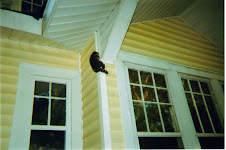HELLO & Welcome to Garden Daddy here at the urban farm! So nice to be able to get online and actually have a good system to visit with you through. I finally got my old system...desktop, old printer, large monitor, many-many cords, etc. out of the way, cleaned off & cleaned up and FINALLY got my new WIFI system up and running. This includes a new wireless mouse for the laptop, a new WIRELESS PRINTER and got the wireless router installed. Your Garden Daddy finally came into the 21st century. With all that said I will move on into urban farm business.
I made a stop over at the Jackson Community Garden Site #4 this week, where I dropped off I think it was exactly 30 landscape timbers that I got from my big box job site for around $0.51 each that had been trimmed down due to being in the cull/cut lumber pile. I plan to use them as bed outline markers to make a neater edge in the garden and make the mulching on the bed perimeters easier as well. I am not making raised beds with these timbers but rather using for aesthetics mostly.
I may however as I can procure more of these timbers for some raised potato beds. Now do not think your Garden Daddy is getting away from his firm belief in row gardening but if you will bear with me I will share with you my thoughts on this process. I say "raised potato beds" loosely as I really should say more like a "potato tower"! Either plan a trench or square or triangle shaped bed. Work the dirt in the base of the tower to loosen soil, probably do this BEFORE placing your planting "box" in the area. Then push your potato eyes about 1/2" into the soil and cover with about 6" of wheat straw or other weed free hay. Keep wet - not flooded but moist. In about 2-weeks you should have some green shoots popping up and then cover these with more straw. Keep this up all season. About 2-weeks after the tops die off it is time to pull the straw back and reveal where your potatoes have grown up and out into the straw and harvest your bounty. You can even start earlier with this process, when the earth reaches around 50-degrees, and then replant in mid-summer for a later fall crop.
The urban chickens continue in their early molt. Or at least half of them are or so. They are really a messy sight now as many of them are bare on their backs and bums. I would be freezing if I was bare like that out in the cold weather we have had the past two months. But at least they will be back feathered in by the heat of summer I hope. My egg production is about 8-eggs a day from the 16 hens now. So at least I am getting enough to eat and still give some away.
I will leave you today now with our ongoing gardening affirmation in mind: "URBAN FARMING: ONE EGG AT A TIME!"
Paint, By Numbers!
14 years ago

















No comments:
Post a Comment